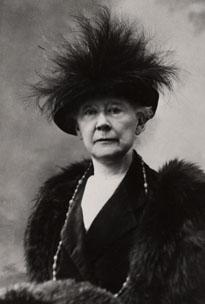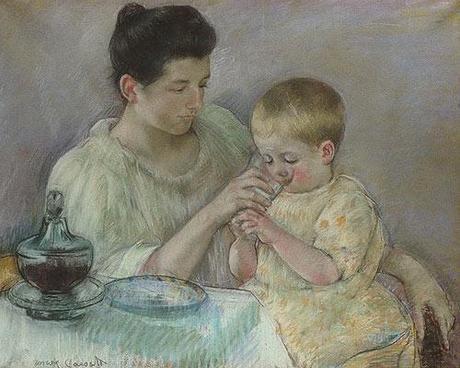
Mary Cassatt: the minx herself
This semester in school I’m taking an Art History class. Full disclosure: I actually did not choose to be in this class, but because of scheduling conflicts was funneled in. In fact, I’m artistically challenged.
This has always been a point of contention for me. I love the arts. I’ve been surrounded by art, music and theatre my entire life – in fact, my Grandmother and Mom are both visual artists and my Dad and Brother are both in the theatre industry. And yet I’m thoroughly untalented. I pick up a paintbrush and I swear the paper tries to escape from my manic clutches.
Therefore, I was incredibly trepidatious in this class (which really is more art than history) until our major project of the semester was assigned. We were to randomly pick an Impressionist from a hat and thoroughly research them and analyze one of their works. I initially chose Ingres. My art teacher saw this and, aware of my infamous feminist reputation, without hesitation snatched the slip of paper with Ingres’ name on it from my indifferent hands and switched it with that of an unassuming boy across the room. I looked down at my new Impressionist. Mary Cassat. Because I’m a girl. Who is a feminist. I must want to study a woman.
Of course, after I got over my little huff at being stereotyped and actually started to research Cassatt (I’ll admit, only a few days before the paper was due. I’m a second semester senior, okay?) I found that I was face to face with one of the coolest feminists I’d ever come across.
Mary Cassatt decided to become a painter as a teen in the 1850’s, and enrolled in the Pennsylvania Academy of the Fine Arts at only 15. However, there she soon found that though the student body was 20% female, most women were there to make themselves more attractive to wealthy suitors (”Look, I married one that can paint! Isn’t that just adorable?”). Cassatt was too good for that shit, so she went to Paris to try to paint professionally. But sexism still persisted in Europe as well, and Cassatt was barred from studying at Paris’ best art school, the Ecole Des Beaux-Arts, because of her gender. Not one to give up, Cassatt decided she didn’t need those assholes anyway and painted on her own in the Louvre until prominent masters – or tutors – of the time decided to take her on. In 1868 one of her paintings was accepted to the prestigious Salon – an institution the male Impressionists were constantly being rejected from. Cassatt was soon after officially invited to join the Impressionists by Degas a few years later, making her one of the few female Impressionists and the only American Impressionist.
See, to me, it would be awesome enough if Cassatt’s merits stopped there. I have so much respect for women who paved the way for girls today to do whatever the hell they want. It’s hard enough to stand up for gender equality in today’s social climate – where we’re admittedly equal to men in many ways – but in a time where women were supposed to worry about getting married and having babies PERIOD Cassatt decided to not only have a career in an almost exclusively male-dominated field, but was really freakin’ amazing at it. RESPECT.
But Cassatt DID take it a step further. One of the major themes of her work was the relationship between a mother and her child. At first, it seems as though Cassatt was painting women because of her own limitations of her gender. She could only push the boundaries so far, right? If she had painted men – or something “serious” – nobody would even give her a second thought. So that’s what she did. But, because the radical bones in a woman like Cassatt’s body can’t be ignored, she embedded subtle feminist critiques about the female gender role into her paintings, while still outwardly appearing socially acceptable.

Mother Feeding Child by Mary Cassatt
In the picture I looked at, Mother Feeding Child, I noticed that while the classic impressionist brushstrokes, light tone and light colors create a scene of an ideal, soft, domestic mother-child relationship – it’s almost a Madonna/Jesus image…talk about idealized mother-child relationship – the mother and child are practically wearing the same thing. It seems like Cassatt might be sending a subtle message about the infantilization of the woman, a critique of how women in the 19th century were treated more like children in society than fully functioning humans. It also can’t be ignored that the entire background is gray and the woman is sallow and unsmiling while the child is simply glowing. As a friend of mine pointed out, the baby is sucking the life out of the woman’s life. Maybe this “idealized” mother isn’t so happy as a mother after all.
So, yes the point is Mary Cassatt was awesome and remembering those trailblazers of yesteryear is an incredibly important part of the modern feminist movement. But in exploring Cassatt, who died in 1926, I’m left wondering why Cassatt could be so prominently recognized in the 19th century as a leader of the movement and yet here in the 21st century the art world is totally phallocentric. For instance, according to a recent article on Cassatt in Mental_Floss Magazine, in 2005 a pathetic three percent of the artists featured in the Modern wing of the Metropolitan Museum of Art were female.
I can’t really offer up a solution to this problem. I am confident that the lack of representation of women in the art world isn’t due to a lack of talent. I mean, hello, Cassatt proved women could paint 150 years ago. There are organizations currently out there – like The Feminist Art Project - that are working to bring female artists into the spotlight. The best we can do is support those organizations, personally support female artists, and keep getting noisy about it. I know I will.

